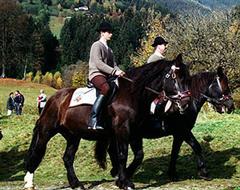Noric
Noriker
Sat, 19th April, 2025 - 2:06 pm GMT
Sponsor Ads:

Alternative Name
NorikerBasic Info
Black horses, bay horses and chestnuts each make up about 90% of the Norics. The remaining 10% are leopards and roans. Desired body measurements in stallions: at least 155 cm withers height, 23 to 25 cm cannon bone, and 205 to 215 cm chest girth.
Health
N/AHabitat
N/ABehavior
Carriage driving courses, horse skidding courses, and the use of this breed as riding, driving, and work horses have increased the importance of Norics. The growing imports of spotted horses from the USA since the 1980s have rekindled interest in colorful Norics. These promising developments have increased the chances of preserving this cultural heritage in Austria. Noric differs from other heavy or draft breeds in several ways. It has quality, nerves and personality, and it is a qualified work horse. Due to the rough environment and special requirements of use in forestry and as a draft and pack animal in the mountains, there was selection for contendedness, toughness, endurance, and tame character.Origin
EuropeHistory
The Noric horse, also known as the Noriker, has been bred for approximately 2000 years in the alpine piedmount of Austria. The recent status and census of this rare domestic animal shows the serious position in conservational breeding. Archeological sites dating back to around 600 BC provide evidence that Celts in the alpine region owned horses, in some cases even spotted horses. After the province "Noricum" was founded by the Romans on the territory of modern-day Austria, heavy breed Roman draught horses were introduced to Central Europe at the time of Christ's birth, giving rise to a new breed of horse. This breed owes its name to the former Roman province Noricum. In the 8th century, under Charlemagne, the breeding of heavy stocks flourished. The first document stud farm for Noric horses was in SchloB Rief near Hallein in 1576. Horse breeding there was in the hands of the archbishops of Salzburg. The frescos of the famous "Pferdeschwamme" in the city of Salzburg portray stylized horses with roman-nosed heads and massive bodies- unmistakably cold-blooded or heavy horses. Many portrayals from that time show how popular unusually colored and patterned horses were, a trend that held until the turn of the 20th century. The Salzburg archbishops continued to promote the breeding of these horses, even drawing up strict guidelines for breeding in the 17th century. These horses largely found use as ceremonial and parade horses, and colorful specimens were highly sought-after. The first inspection regulations for stallions were drafted in 1703. In the 18th century, Noric horses became important as work animals in the agricultural sector. The farmers soon realized, however, that those horses considered by the archbishops to be of a better breed (i.e. those interbred with Neapolitan and Andalusian warm-blooded horses to produce riding and carriage horses) were not optimal for work in alpine regions. Preference was again given to the more common type of heavy work horses, which were less temperamental in difficult terrain. With time, the landscape, climate, ground, and hard work on farms gave these horses the build and characteristics of a versatile cold-blooded breed. The result was the heavy alpine Noric, which ultimately served as a riding, carriage, and work horse for knights, farmers, and merchants in the Middle Ages.Common Foods
grassSponsor Ads:
"Violence is the last refuge of the incompetent" -- Isaac Asimov
Noric
Coded by: BGID® | ALL RIGHTS RESERVED Copyright © 2000-2025
Disclaimer | Privacy | Report Errors / Contact | Credits








 President of the United States of America - Real Estate mogul, Pageant owner and now one of the most controversial men in political history.
President of the United States of America - Real Estate mogul, Pageant owner and now one of the most controversial men in political history.  Politician, US Vice President and President of the USA - Joseph Robinette Biden Jr.
Politician, US Vice President and President of the USA - Joseph Robinette Biden Jr.  versus
versus  Russia: 'The Evil Empire'? Are they all that bad or is it just the USA trying to portray Russia as bad because they are a world power with land bigger and a society very different from the USA ideal?
Russia: 'The Evil Empire'? Are they all that bad or is it just the USA trying to portray Russia as bad because they are a world power with land bigger and a society very different from the USA ideal?  Global warming has been in and out as the "latest" hot topic for many years. It is, according to modern scientists, the result of man-made industrial pollutants, clearing forested areas, agriculture, etc. But now they are thinking it started way before the Industrial Revolution...
Global warming has been in and out as the "latest" hot topic for many years. It is, according to modern scientists, the result of man-made industrial pollutants, clearing forested areas, agriculture, etc. But now they are thinking it started way before the Industrial Revolution... 
 Corona virus
Corona virus 
 Users with wide screen monitors can benefit from more content on every page.
Users with wide screen monitors can benefit from more content on every page.